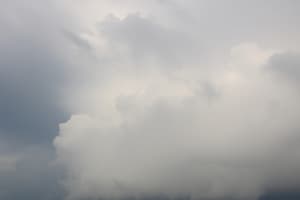Podcast
Questions and Answers
What process leads to the formation of cumulonimbus clouds?
What process leads to the formation of cumulonimbus clouds?
- Moist air flowing from the ocean
- Rapid cooling of air at ground level
- High evaporation and rapid condensation (correct)
- Air rising over a mountain range
What happens to air as it rises up a slope in relief rain?
What happens to air as it rises up a slope in relief rain?
- It descends and increases in temperature
- It warms up and loses moisture
- It retains constant humidity
- It cools down and increases in relative humidity (correct)
Which condition is necessary for condensation to occur, resulting in precipitation?
Which condition is necessary for condensation to occur, resulting in precipitation?
- Air must be warmed continuously
- Air must reach a temperature of 0 degrees Celsius
- Relative humidity must be less than 50%
- Relative humidity must reach 100% (correct)
What characterizes convectional rainfall in terms of intensity?
What characterizes convectional rainfall in terms of intensity?
What is a key characteristic of the leeward side of a mountain in terms of precipitation?
What is a key characteristic of the leeward side of a mountain in terms of precipitation?
Flashcards are hidden until you start studying
Study Notes
Convectional Rain
- Occurs due to direct heating of the Earth's surface.
- Warm air near the ground rises, cools, and condenses into water droplets.
- Condensation occurs on dust particles, merging into larger clouds called cumulonimbus clouds.
- Characterized by intense rainfall, thunder, and lightning.
Relief Rain
- Forms when moist air is forced to rise over a mountain or slope.
- As air ascends, it cools, leading to condensation and cloud formation.
- Rainfall occurs on the windward side of the slope where air is forced to rise.
- The leeward side typically remains dry due to descending air warming and reducing relative humidity.
Studying That Suits You
Use AI to generate personalized quizzes and flashcards to suit your learning preferences.




